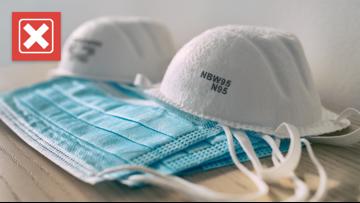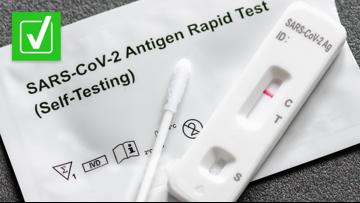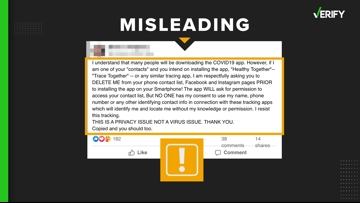COVID-19 cases in the U.S. are at record numbers, fueled by the spread of the omicron variant. The country’s daily test volume has risen in tandem, and is now at its highest compared to any other point during the pandemic.
Americans can now order four free at-home COVID-19 tests from the United States Postal Service (USPS), improving access to testing for people at home. Though at-home tests are intended to read samples taken from the nose, some social media users have claimed that throat swabs are more effective than nasal swabs, citing doctors and studies that have allegedly said it’s the best way to detect the omicron variant.
That led to Holly, a VERIFY viewer, asking the VERIFY team in an email if swabbing your throat will give you more accurate COVID-19 test results than swabbing your nostrils.
THE QUESTION
Should you swab the back of your throat instead of your nose to test for COVID-19?
THE SOURCES
Dr. William Schaffner, an infectious disease expert at the Vanderbilt University School of Medicine
Dr. Jaimie Meyer, an infectious disease expert with Yale Medicine
Dr. Joshua Levy, an expert in head and neck surgery at Emory University
THE ANSWER
No, you should not swab the back of your throat instead of your nose to test for COVID-19.
WHAT WE FOUND
Experts say it’s dangerous for you to try to swab the back of your own throat for a self-test and that you should always follow the directions of the test kit you’re using.
The Food and Drug Administration (FDA) explains samples for diagnostic COVID-19 tests are typically collected with a nasal or throat swab; in some cases, saliva can also be collected for testing. Nasal swabs refer to samples taken from just inside the nostrils or a little deeper, while throat swabs are collected in the back of the throat by pushing the swab all the way through the nose or by swabbing the area beyond the mouth.


In a series of emailed responses to VERIFY, an FDA spokesperson explained that while nasopharyngeal swabs — throat swabs taken from the nose — are the most accurate, nasal swabs are recommended by the Centers for Disease Control and Prevention (CDC) as acceptable alternatives for testing because of relatively comparable performance between the two swabs. But the spokesperson stressed that people shouldn’t try to collect throat swabs for at-home tests.
“The FDA advises that COVID-19 tests should be used as authorized, including following their instructions for use regarding obtaining the sample for testing,” the spokesperson said. “The FDA has noted safety concerns regarding self-collection of throat swabs, as they are more complicated than nasal swabs – and if used incorrectly, can cause harm to the patient. The CDC recommends that throat swabs be collected by a trained healthcare provider.”
Dr. William Schaffner, an infectious disease expert at the Vanderbilt University School of Medicine, agreed, explaining at-home tests weren’t designed to collect throat swabs.
“We have to understand that the tests that have been licensed for use, read the instructions carefully, they were designed to get nasal specimens,” Schaffner said. “They weren't designed to get throat specimens.”
But it’s not just at-home tests that are now using nasal swabs. Trained healthcare professionals have switched to nasal swabs for most COVID-19 tests, said Dr. Jaimie Meyer, an infectious disease expert with Yale Medicine.
“When we were doing these very invasive swabs, people not only found it uncomfortable — and so they might avoid getting tested — but they also often coughed when they were testing, so you're putting the person who's testing you at risk,” Meyer said. “So it's a lot more appealing to do a nasal swab. It still is very good, and it also allows for home tests to happen.”
And throat tests pose even more of a risk to a person administering it to themselves, said Dr. Joshua Levy, an expert in head and neck surgery at Emory University.
“[When] swabbing the back of your throat, you can make yourself gag, you can choke,” Levy said. “It doesn't make sense to me at all to do.”
On top of all the risks, swabbing your own throat is just not as easy as swabbing the inside of your nostrils.
“I don't know if any of us have ever tried to do a swab all the way in the back of our nose and throat, but that's very hard to do,” Meyer said.
The CDC provides a guide online on how to get a nasal swab for a COVID-19 test. It says to stick the swab no more than three-quarters of an inch up your nose and slowly rotate it at least four times for 15 seconds.
More from VERIFY: No, the CDC doesn’t count positive results from at-home COVID-19 tests













